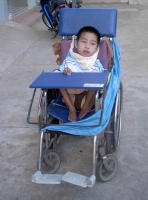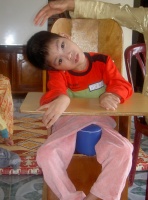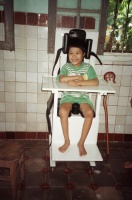Assistive Devices for Cerebral Palsy: Difference between revisions
Michelle Lee (talk | contribs) (Created page with "<div class="editorbox">
Original Editor - Roelie Wolting<br> Top Contributors - {{Special:Contributors/{{FULLPAGENAME}}}}
</div> == Introduction =...") |
Michelle Lee (talk | contribs) No edit summary |
||
| Line 11: | Line 11: | ||
|} | |} | ||
== Introduction to Assistive Devices == | == Introduction to Assistive Devices == | ||
Many children with cerebral palsy can be more independent with the help of (simple) equipment. <br>Some children with cerebral palsy need (simple) equipment in order to prevent contractures and deformities. | Many children with cerebral palsy can be more independent with the help of (simple) equipment. <br>Some children with cerebral palsy need (simple) equipment in order to prevent contractures and deformities. | ||
Some principles: | Some principles: | ||
*There is not one size which fits all. | |||
*So: you will not find all answers here. Be creative and find different ideas. | |||
*Discuss with the child and the family first: do not give people equipment because you think it is needed. Make sure the family wants to use it. | |||
*Children grow, so the equipment should grow with them.<br> | |||
Below are some photos of assistive devices that are not necessarily correct for the child: | |||
the chair does not support him enough: not helping to keep his head up, the knees are “falling” side-wards, the arms are turned inwards.<br>(this is a very floppy boy; this picture does not show a “bad position at the wrong time” but reflects the reality. This was during a session on finding the best chair for him) | |||
{| width="200" border="1" align="center" cellpadding="1" cellspacing="1" | |||
|- | |||
| [[Image:CP_wchair.jpg|thumb|center|150x200px]] | |||
| [[Image:CP_chair.jpg|thumb|center|150x200px]] | |||
| [[Image:CP_supportive_chair.jpg|thumb|center|150x200px]] | |||
|- | |||
| Wheelchair is far too big for him. <br>(but the grandmother, who is taking care of him is very happy with it, because she does not need to carry him).<br> | |||
| The chair does not support him enough: not helping to keep his head up, the knees are “falling” side-wards, the arms are turned inwards.<br>(this is a very floppy boy; this picture does not show a “bad position at the wrong time” but reflects the reality. This was during a session on finding the best chair for him)<br> | |||
| Does not look as if she needs this much of support;<br>(this girl could sit independently; just needed a chair so she could put her feet on the floor; no need for a special chair)<br> | |||
|} | |||
Revision as of 19:41, 21 August 2016
Top Contributors - Rucha Gadgil, Michelle Lee, Kim Jackson, Simisola Ajeyalemi, Naomi O'Reilly, Roelie Wolting, Laura Ritchie, Olajumoke Ogunleye, Aminat Abolade, Shaimaa Eldib, Lucinda hampton, Jess Bell, Nupur Smit Shah, Angeliki Chorti and Evan Thomas
Introduction [edit | edit source]
The information on this page has developed for you from the expert work of Roelie Wolting alongside the Enablement Cerebral Palsy Project and Handicap International Group.
Introduction to Assistive Devices[edit | edit source]
Many children with cerebral palsy can be more independent with the help of (simple) equipment.
Some children with cerebral palsy need (simple) equipment in order to prevent contractures and deformities.
Some principles:
- There is not one size which fits all.
- So: you will not find all answers here. Be creative and find different ideas.
- Discuss with the child and the family first: do not give people equipment because you think it is needed. Make sure the family wants to use it.
- Children grow, so the equipment should grow with them.
Below are some photos of assistive devices that are not necessarily correct for the child:
the chair does not support him enough: not helping to keep his head up, the knees are “falling” side-wards, the arms are turned inwards.
(this is a very floppy boy; this picture does not show a “bad position at the wrong time” but reflects the reality. This was during a session on finding the best chair for him)
| Wheelchair is far too big for him. (but the grandmother, who is taking care of him is very happy with it, because she does not need to carry him). |
The chair does not support him enough: not helping to keep his head up, the knees are “falling” side-wards, the arms are turned inwards. (this is a very floppy boy; this picture does not show a “bad position at the wrong time” but reflects the reality. This was during a session on finding the best chair for him) |
Does not look as if she needs this much of support; (this girl could sit independently; just needed a chair so she could put her feet on the floor; no need for a special chair) |












